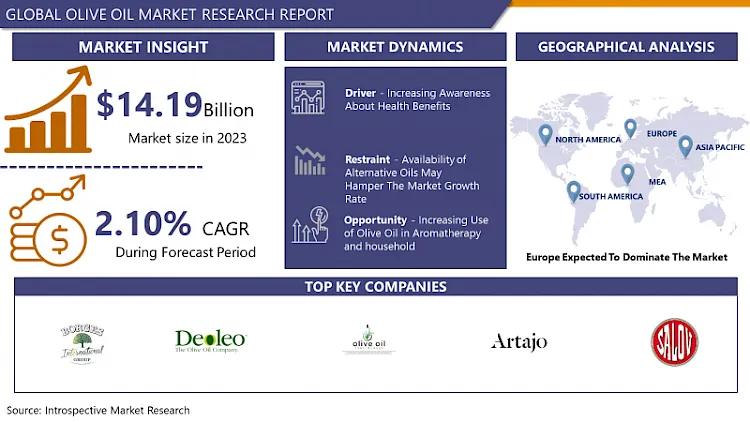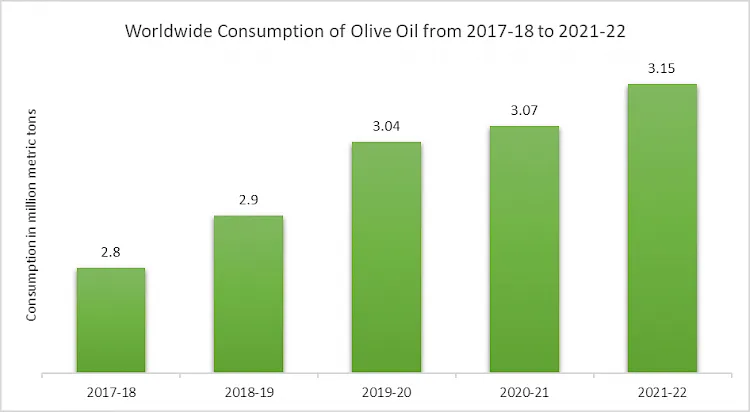Olive Oil Market Synopsis
The Olive Oil Market size is estimated at 14.19 billion USD in 2023 and is expected to reach 17.11 billion USD by 2032, growing at a CAGR of 2.10% during the forecast period (2024-2032)
Olive oil is a liquid fat obtained by pressing whole olives (the fruit of Olea europaea family Oleaceae), a traditional tree crop of the Mediterranean Basin, and extracting the oil. It is commonly used in cooking, for frying foods, or as a salad dressing. It can also be found in some cosmetics, pharmaceuticals, soaps, and fuels for traditional oil lamps.
- It also has additional uses in some religions. The olive is one of three core food plants in Mediterranean cuisine, together with wheat and grapes. Olive trees have been grown around the Mediterranean since the 8th millennium BC.
- The growing demand from food industries is also driving the growth of the market. Compared to other cooking oils, olive oil has the unique potential to deliver a one-two punch to chronic and degenerative diseases from the potent polyphenol compounds found in extra virgin olive oil and the high percentage of monounsaturated fatty acids (MUFAs) found in all grades.
- Increasing healthy diet awareness is also expected to impact the growth of the market positively. The health benefits of olive oil have been attributed to its antioxidant and anti-inflammatory properties. Observational studies have shown a link between lower risks of cardiovascular disease and some cancers.

The Olive Oil Market Trend Analysis
Increasing Awareness About Health Benefits From olive oil
- Health advantages of olive oil abound. Healthy monounsaturated fats are abundant in olive oil. Saturated fat makes up about 14% of the oil, while polyunsaturated fats like omega-6 and omega-3 fatty acids make up 11% of it.
- A large review of studies in 841,000 people found that olive oil was the only source of monounsaturated fat associated with a reduced risk of stroke and heart disease. Extra virgin olive oil has numerous benefits for heart health. It lowers blood pressure, protects “bad” LDL cholesterol particles from oxidation, and improves the function of blood vessels.
- The demand for healthy edible oils increased in emerging economies like India during COVID-19 as olive fruit oil began to gain shelf space in Indian households for recreating restaurant-like gourmet experiences at home.
- The growing interest of individuals in raw, natural, and cold-pressed cooking oils as they are attributed to be safer and healthier in comparison to their processed counterparts has supported the market growth.

This statistic shows the consumption of olive oil worldwide from 2017/18 to 2021/22. In 2021/22, the global consumption volume of olive oil amounted to just under 3.15 million metric tons.
Increasing Use of Olive Oil in Aromatherapy and household
- The health benefits of olive oil make it an extremely attractive ingredient to use for cooking. Packed with polyphenols, amino acids, and healthy monounsaturated fats, olive oil can be a key factor not only in establishing a balanced diet but also in adding depth and flavor to food.
- Olive oil is pressed from olives growing in the Mediterranean region. In the pharmaceutical industry, it has also been used as a vehicle for oily suspensions for injections and topically as a demulcent and emollient in creams or ointments. In years past, it was used as a laxative.
- Olive oil has been used since ancient times as a cosmetic and to aid skin healing. The ancient Egyptians used it as an anti-wrinkle potion; the Romans used it as a moisturizer after bathing. To this day, olive oil is used widely in many countries to treat and prevent multiple skin conditions.
- Olive oil is used for therapeutic benefits. However, due to its wide health benefits, olive oil is mostly used in aromatherapy which is increasing the demand for olive oil. Thus, increasing use in aromatherapy and household and driving the Olive Oil Market.
Segmentation Analysis of The Olive Oil Market
Olive Oil market segments cover the Type, Application, Distribution Channel, and End-users. By Type, The Virgin segment is Anticipated to Dominate the Market Over the Forecast period.
- Virgin olive oil is obtained directly from the ripe fruit by mechanical procedures. It is the only consumed raw without the use of any solvents, so it keeps all its properties intact. Olive oil has excellent antioxidants such as polyphenols and vitamin E, which are lost if the oil is subjected to refining processes.
- Virgin olive oil is mostly used as a salad dressing and as an ingredient in salad dressings. It is also used with foods to be eaten cold. If uncompromised by heat, the flavor is stronger. It also can be used for sautéing.
- Virgin olive oil is a high-quality natural product obtained only by physical means. In addition to triacylglycerols, it contains nutritionally important polar and non-polar antioxidant phenols and other bioactive ingredients.
Regional Analysis of The Olive Oil Market
Europe is Expected to Dominate the Market Over the Forecast period.
- The market in Europe is further fueled by consumers' increased interest in healthy oils as a means of avoiding lifestyle-related health issues that can arise from their hectic lifestyles. As a result, enterprises intending to enter the worldwide olive oil sector find these regions to be the most enticing.
- Spain is the world’s largest producer of olive oil. According to the Food Information and Control Agency (AICA), Spain produced 1.3 million tonnes of olive oil in 2021, accounting for 42% of global olive oil production. Spain is also the largest olive oil exporter, with a share of 49% in 2021, followed by Greece (13%), Italy (11%), Tunisia (11%), and Portugal (10%).
- Europe is the largest importing region of olive oil in the world. In 2021, European imports of olive oil accounted for 86% of the world’s total value of olive oil imports. European imports of olive oil recorded a slight decrease of 4% compared to 2020. Most of the olive oil trade in Europe is produced in the region, mainly in Spain and Italy.
- European countries import most of their olive oil from other European countries (intra-European trade). In 2021, 13% of Europe’s imports of olive oil came from developing countries. The biggest share of intra-European trade consists of bulk olive oil blended by the largest olive oil companies before bottling. Significant volumes of bulk olive oil are not traded but only moved across borders by these companies for processing. For example, the leading European olive oil producer has facilities in both Spain and Italy, which exchange the company’s olive oil among them during processing.
- European olive oil consumption was estimated at 1.46 million tonnes in 2021, which is approximately half of the total world consumption. Italy and Spain are the largest consumers of olive oil in the EU, with annual consumptions of around 500,000 tonnes each, while Greece has the biggest EU per capita consumption, with around 12 kg per person per year.
Covid-19 Impact Analysis On Olive Oil Market
The global market for organic olive oil grew as a result of the COVID-19 pandemic's outbreak. Consumers started including organic olive oil in their daily diets as a result of rising health concerns. Olive oil is widely used in a variety of products, including dietary supplements, food & beverages, and pharmaceuticals. Products containing organic olive oil are also used to cure chronic diseases. This factor led to high demand for organic olive oil products in the market. COVID-19 also has affected the market to some extent due to the lockdown. The manufacturing process was halted as well as the demand from the end users also decreased, which affected the market.
Top Key Players Covered in The Olive Oil Market
- Borges International Group(Spain)
- Deoleo S.A. (Spain)
- EU Olive Oil (U.K.)
- Artajo oil(Spain)
- SALOV GROUP (Italy)
- Aceites Sandúa (Spain)
- Tucan Olive Oil Company (U.S.)
- Domenico Manca S.p.a (Italy)
- Minerva Foods(Greece)
- Olinexo S.L. (Spain)
- Nutrinveste SGPS (Portugal)
- Curation Foods (U.S.), and Other Major Players
Key Industry Developments in the Olive Oil Market
- In December2023: North American Olive Oil Association announced a new certification program for sustainable olive oil production practices, encouraging ethical and environmentally responsible sourcing.
- In December 2023, Brio Partnered with a leading medical research institute to launch a study investigating the potential of olive oil in managing cholesterol levels.
- In November 2023, La Mancha DOP announced a partnership with World Wildlife Fund (WWF) to launch a reforestation project, planting 10,000 olive trees in Spain to combat climate change and preserve biodiversity.
- In October 2023, Colavita Introduced a new line of organic & carbon-neutral extra virgin olive oils from Italy, highlighting sustainability and environmental consciousness.
|
Global Olive Oil Market |
|||
|
Base Year: |
2023 |
Forecast Period: |
2024-2032 |
|
Historical Data: |
2017 to 2023 |
Market Size in 2023: |
USD 14.19 Bn. |
|
Forecast Period 2024-2032 CAGR: |
2.10% |
Market Size in 2032: |
USD 17.11 Bn |
|
Segments Covered: |
By Type |
|
|
|
By Application |
|
||
|
By Distribution Channel |
|
||
|
By End Users |
|
||
|
By Region |
|
||
|
Key Market Drivers: |
|
||
|
Key Market Restraints: |
|
||
|
Key Opportunities: |
|
||
|
Companies Covered in the report: |
|
||
Chapter 1: Introduction
1.1 Research Objectives
1.2 Research Methodology
1.3 Research Process
1.4 Scope and Coverage
1.4.1 Market Definition
1.4.2 Key Questions Answered
1.5 Market Segmentation
Chapter 2:Executive Summary
Chapter 3:Growth Opportunities By Segment
3.1 By Type
3.2 By Application
3.3 By Distribution Channel
3.4 By End Users
Chapter 4: Market Landscape
4.1 Porter's Five Forces Analysis
4.1.1 Bargaining Power of Supplier
4.1.2 Threat of New Entrants
4.1.3 Threat of Substitutes
4.1.4 Competitive Rivalry
4.1.5 Bargaining Power Among Buyers
4.2 Industry Value Chain Analysis
4.3 Market Dynamics
4.3.1 Drivers
4.3.2 Restraints
4.3.3 Opportunities
4.5.4 Challenges
4.4 Pestle Analysis
4.5 Technological Roadmap
4.6 Regulatory Landscape
4.7 SWOT Analysis
4.8 Price Trend Analysis
4.9 Patent Analysis
4.10 Analysis of the Impact of Covid-19
4.10.1 Impact on the Overall Market
4.10.2 Impact on the Supply Chain
4.10.3 Impact on the Key Manufacturers
4.10.4 Impact on the Pricing
Chapter 5: Olive Oil Market by Type
5.1 Olive Oil Market Overview Snapshot and Growth Engine
5.2 Olive Oil Market Overview
5.3 Virgin
5.3.1 Introduction and Market Overview
5.3.2 Historic and Forecasted Market Size (2017-2032F)
5.3.3 Key Market Trends, Growth Factors and Opportunities
5.3.4 Virgin: Geographic Segmentation
5.4 Refined
5.4.1 Introduction and Market Overview
5.4.2 Historic and Forecasted Market Size (2017-2032F)
5.4.3 Key Market Trends, Growth Factors and Opportunities
5.4.4 Refined: Geographic Segmentation
5.5 Others
5.5.1 Introduction and Market Overview
5.5.2 Historic and Forecasted Market Size (2017-2032F)
5.5.3 Key Market Trends, Growth Factors and Opportunities
5.5.4 Others: Geographic Segmentation
Chapter 6: Olive Oil Market by Application
6.1 Olive Oil Market Overview Snapshot and Growth Engine
6.2 Olive Oil Market Overview
6.3 Food And Beverages
6.3.1 Introduction and Market Overview
6.3.2 Historic and Forecasted Market Size (2017-2032F)
6.3.3 Key Market Trends, Growth Factors and Opportunities
6.3.4 Food And Beverages: Geographic Segmentation
6.4 Pharmaceutical
6.4.1 Introduction and Market Overview
6.4.2 Historic and Forecasted Market Size (2017-2032F)
6.4.3 Key Market Trends, Growth Factors and Opportunities
6.4.4 Pharmaceutical: Geographic Segmentation
6.5 Cosmetic And Personal Care
6.5.1 Introduction and Market Overview
6.5.2 Historic and Forecasted Market Size (2017-2032F)
6.5.3 Key Market Trends, Growth Factors and Opportunities
6.5.4 Cosmetic And Personal Care: Geographic Segmentation
6.6 Aromatherapy
6.6.1 Introduction and Market Overview
6.6.2 Historic and Forecasted Market Size (2017-2032F)
6.6.3 Key Market Trends, Growth Factors and Opportunities
6.6.4 Aromatherapy: Geographic Segmentation
6.7 Others
6.7.1 Introduction and Market Overview
6.7.2 Historic and Forecasted Market Size (2017-2032F)
6.7.3 Key Market Trends, Growth Factors and Opportunities
6.7.4 Others: Geographic Segmentation
Chapter 7: Olive Oil Market by Distribution Channel
7.1 Olive Oil Market Overview Snapshot and Growth Engine
7.2 Olive Oil Market Overview
7.3 Online
7.3.1 Introduction and Market Overview
7.3.2 Historic and Forecasted Market Size (2017-2032F)
7.3.3 Key Market Trends, Growth Factors and Opportunities
7.3.4 Online: Geographic Segmentation
7.4 Supermarkets or Hypermarkets
7.4.1 Introduction and Market Overview
7.4.2 Historic and Forecasted Market Size (2017-2032F)
7.4.3 Key Market Trends, Growth Factors and Opportunities
7.4.4 Supermarkets or Hypermarkets: Geographic Segmentation
7.5 Specialty Store
7.5.1 Introduction and Market Overview
7.5.2 Historic and Forecasted Market Size (2017-2032F)
7.5.3 Key Market Trends, Growth Factors and Opportunities
7.5.4 Specialty Store: Geographic Segmentation
7.6 Others
7.6.1 Introduction and Market Overview
7.6.2 Historic and Forecasted Market Size (2017-2032F)
7.6.3 Key Market Trends, Growth Factors and Opportunities
7.6.4 Others: Geographic Segmentation
Chapter 8: Olive Oil Market by End Users
8.1 Olive Oil Market Overview Snapshot and Growth Engine
8.2 Olive Oil Market Overview
8.3 Food and Beverage
8.3.1 Introduction and Market Overview
8.3.2 Historic and Forecasted Market Size (2017-2032F)
8.3.3 Key Market Trends, Growth Factors and Opportunities
8.3.4 Food and Beverage: Geographic Segmentation
8.4 Personal Care
8.4.1 Introduction and Market Overview
8.4.2 Historic and Forecasted Market Size (2017-2032F)
8.4.3 Key Market Trends, Growth Factors and Opportunities
8.4.4 Personal Care: Geographic Segmentation
8.5 Pharmaceuticals
8.5.1 Introduction and Market Overview
8.5.2 Historic and Forecasted Market Size (2017-2032F)
8.5.3 Key Market Trends, Growth Factors and Opportunities
8.5.4 Pharmaceuticals: Geographic Segmentation
8.6 Others
8.6.1 Introduction and Market Overview
8.6.2 Historic and Forecasted Market Size (2017-2032F)
8.6.3 Key Market Trends, Growth Factors and Opportunities
8.6.4 Others: Geographic Segmentation
Chapter 9: Company Profiles and Competitive Analysis
9.1 Competitive Landscape
9.1.1 Competitive Positioning
9.1.2 Olive Oil Sales and Market Share By Players
9.1.3 Industry BCG Matrix
9.1.4 Heat Map Analysis
9.1.5 Olive Oil Industry Concentration Ratio (CR5 and HHI)
9.1.6 Top 5 Olive Oil Players Market Share
9.1.7 Mergers and Acquisitions
9.1.8 Business Strategies By Top Players
9.2 BORGES INTERNATIONAL GROUP (SPAIN)
9.2.1 Company Overview
9.2.2 Key Executives
9.2.3 Company Snapshot
9.2.4 Operating Business Segments
9.2.5 Product Portfolio
9.2.6 Business Performance
9.2.7 Key Strategic Moves and Recent Developments
9.2.8 SWOT Analysis
9.3 DEOLEO S.A. (SPAIN)
9.4 EU OLIVE OIL (U.K.)
9.5 ARTAJO OIL (SPAIN)
9.6 SALOV GROUP (ITALY)
9.7 ACEITES SANDÚA (SPAIN)
9.8 TUCAN OLIVE OIL COMPANY (U.S.)
9.9 DOMENICO MANCA S.P.A (ITALY)
9.10 MINERVA FOODS (GREECE)
9.11 OLINEXO S.L. (SPAIN)
9.12 NUTRINVESTE SGPS (PORTUGAL)
9.13 CURATION FOODS (U.S.)
9.14 OTHER MAJOR PLAYERS.
Chapter 10: Global Olive Oil Market Analysis, Insights and Forecast, 2017-2032
10.1 Market Overview
10.2 Historic and Forecasted Market Size By Type
10.2.1 Virgin
10.2.2 Refined
10.2.3 Others
10.3 Historic and Forecasted Market Size By Application
10.3.1 Food And Beverages
10.3.2 Pharmaceutical
10.3.3 Cosmetic And Personal Care
10.3.4 Aromatherapy
10.3.5 Others
10.4 Historic and Forecasted Market Size By Distribution Channel
10.4.1 Online
10.4.2 Supermarkets or Hypermarkets
10.4.3 Specialty Store
10.4.4 Others
10.5 Historic and Forecasted Market Size By End Users
10.5.1 Food and Beverage
10.5.2 Personal Care
10.5.3 Pharmaceuticals
10.5.4 Others
Chapter 11: North America Olive Oil Market Analysis, Insights and Forecast, 2017-2032
11.1 Key Market Trends, Growth Factors and Opportunities
11.2 Impact of Covid-19
11.3 Key Players
11.4 Key Market Trends, Growth Factors and Opportunities
11.4 Historic and Forecasted Market Size By Type
11.4.1 Virgin
11.4.2 Refined
11.4.3 Others
11.5 Historic and Forecasted Market Size By Application
11.5.1 Food And Beverages
11.5.2 Pharmaceutical
11.5.3 Cosmetic And Personal Care
11.5.4 Aromatherapy
11.5.5 Others
11.6 Historic and Forecasted Market Size By Distribution Channel
11.6.1 Online
11.6.2 Supermarkets or Hypermarkets
11.6.3 Specialty Store
11.6.4 Others
11.7 Historic and Forecasted Market Size By End Users
11.7.1 Food and Beverage
11.7.2 Personal Care
11.7.3 Pharmaceuticals
11.7.4 Others
11.8 Historic and Forecast Market Size by Country
11.8.1 U.S.
11.8.2 Canada
11.8.3 Mexico
Chapter 12: Europe Olive Oil Market Analysis, Insights and Forecast, 2017-2032
12.1 Key Market Trends, Growth Factors and Opportunities
12.2 Impact of Covid-19
12.3 Key Players
12.4 Key Market Trends, Growth Factors and Opportunities
12.4 Historic and Forecasted Market Size By Type
12.4.1 Virgin
12.4.2 Refined
12.4.3 Others
12.5 Historic and Forecasted Market Size By Application
12.5.1 Food And Beverages
12.5.2 Pharmaceutical
12.5.3 Cosmetic And Personal Care
12.5.4 Aromatherapy
12.5.5 Others
12.6 Historic and Forecasted Market Size By Distribution Channel
12.6.1 Online
12.6.2 Supermarkets or Hypermarkets
12.6.3 Specialty Store
12.6.4 Others
12.7 Historic and Forecasted Market Size By End Users
12.7.1 Food and Beverage
12.7.2 Personal Care
12.7.3 Pharmaceuticals
12.7.4 Others
12.8 Historic and Forecast Market Size by Country
12.8.1 Germany
12.8.2 U.K.
12.8.3 France
12.8.4 Italy
12.8.5 Russia
12.8.6 Spain
12.8.7 Rest of Europe
Chapter 13: Asia-Pacific Olive Oil Market Analysis, Insights and Forecast, 2017-2032
13.1 Key Market Trends, Growth Factors and Opportunities
13.2 Impact of Covid-19
13.3 Key Players
13.4 Key Market Trends, Growth Factors and Opportunities
13.4 Historic and Forecasted Market Size By Type
13.4.1 Virgin
13.4.2 Refined
13.4.3 Others
13.5 Historic and Forecasted Market Size By Application
13.5.1 Food And Beverages
13.5.2 Pharmaceutical
13.5.3 Cosmetic And Personal Care
13.5.4 Aromatherapy
13.5.5 Others
13.6 Historic and Forecasted Market Size By Distribution Channel
13.6.1 Online
13.6.2 Supermarkets or Hypermarkets
13.6.3 Specialty Store
13.6.4 Others
13.7 Historic and Forecasted Market Size By End Users
13.7.1 Food and Beverage
13.7.2 Personal Care
13.7.3 Pharmaceuticals
13.7.4 Others
13.8 Historic and Forecast Market Size by Country
13.8.1 China
13.8.2 India
13.8.3 Japan
13.8.4 Singapore
13.8.5 Australia
13.8.6 New Zealand
13.8.7 Rest of APAC
Chapter 14: Middle East & Africa Olive Oil Market Analysis, Insights and Forecast, 2017-2032
14.1 Key Market Trends, Growth Factors and Opportunities
14.2 Impact of Covid-19
14.3 Key Players
14.4 Key Market Trends, Growth Factors and Opportunities
14.4 Historic and Forecasted Market Size By Type
14.4.1 Virgin
14.4.2 Refined
14.4.3 Others
14.5 Historic and Forecasted Market Size By Application
14.5.1 Food And Beverages
14.5.2 Pharmaceutical
14.5.3 Cosmetic And Personal Care
14.5.4 Aromatherapy
14.5.5 Others
14.6 Historic and Forecasted Market Size By Distribution Channel
14.6.1 Online
14.6.2 Supermarkets or Hypermarkets
14.6.3 Specialty Store
14.6.4 Others
14.7 Historic and Forecasted Market Size By End Users
14.7.1 Food and Beverage
14.7.2 Personal Care
14.7.3 Pharmaceuticals
14.7.4 Others
14.8 Historic and Forecast Market Size by Country
14.8.1 Turkey
14.8.2 Saudi Arabia
14.8.3 Iran
14.8.4 UAE
14.8.5 Africa
14.8.6 Rest of MEA
Chapter 15: South America Olive Oil Market Analysis, Insights and Forecast, 2017-2032
15.1 Key Market Trends, Growth Factors and Opportunities
15.2 Impact of Covid-19
15.3 Key Players
15.4 Key Market Trends, Growth Factors and Opportunities
15.4 Historic and Forecasted Market Size By Type
15.4.1 Virgin
15.4.2 Refined
15.4.3 Others
15.5 Historic and Forecasted Market Size By Application
15.5.1 Food And Beverages
15.5.2 Pharmaceutical
15.5.3 Cosmetic And Personal Care
15.5.4 Aromatherapy
15.5.5 Others
15.6 Historic and Forecasted Market Size By Distribution Channel
15.6.1 Online
15.6.2 Supermarkets or Hypermarkets
15.6.3 Specialty Store
15.6.4 Others
15.7 Historic and Forecasted Market Size By End Users
15.7.1 Food and Beverage
15.7.2 Personal Care
15.7.3 Pharmaceuticals
15.7.4 Others
15.8 Historic and Forecast Market Size by Country
15.8.1 Brazil
15.8.2 Argentina
15.8.3 Rest of SA
Chapter 16 Investment Analysis
Chapter 17 Analyst Viewpoint and Conclusion
|
Global Olive Oil Market |
|||
|
Base Year: |
2023 |
Forecast Period: |
2024-2032 |
|
Historical Data: |
2017 to 2023 |
Market Size in 2023: |
USD 14.19 Bn. |
|
Forecast Period 2024-2032 CAGR: |
2.10% |
Market Size in 2032: |
USD 17.11 Bn |
|
Segments Covered: |
By Type |
|
|
|
By Application |
|
||
|
By Distribution Channel |
|
||
|
By End Users |
|
||
|
By Region |
|
||
|
Key Market Drivers: |
|
||
|
Key Market Restraints: |
|
||
|
Key Opportunities: |
|
||
|
Companies Covered in the report: |
|
||
Frequently Asked Questions :
The forecast period in the Olive Oil Market research report is 2024-2032.
Borges International Group (Spain), Deoleo S.A. (Spain), EU Olive Oil (U.K.), Artajo oil (Spain), SALOV GROUP (Italy), Aceites Sandúa (Spain), Tucan Olive Oil Company (U.S.), Domenico Manca S.p.a (Italy), Minerva Foods (Greece), Olinexo S.L. (Spain), Nutrinveste SGPS (Portugal), Curation Foods (U.S.), and other major Players.
The Olive Oil Market is segmented into Type, Application, Distribution Channel, End Users, and region. By Type, the market is categorized into Virgin, Refined, and Others. By Application, the market is categorized into Food and Beverages, Pharmaceutical, Cosmetic and Personal Care, Aromatherapy, and Others. By Distribution Channel, the market is categorized into Online, Supermarkets or Hypermarkets, Specialty Store and Others. By End Users, the market is categorized into Food and Beverage, Personal Care, Pharmaceuticals and Others. By region, it is analyzed across North America (U.S.; Canada; Mexico), Europe (Germany; U.K.; France; Italy; Russia; Spain, etc.), Asia-Pacific (China; India; Japan; Southeast Asia, etc.), South America (Brazil; Argentina, etc.), Middle East & Africa (Saudi Arabia; South Africa, etc.).
Olive oil is a liquid fat obtained by pressing whole olives (the fruit of Olea europaea; family Oleaceae), a traditional tree crop of the Mediterranean Basin, and extracting the oil. It is commonly used in cooking, for frying foods, or as a salad dressing. It can also be found in some cosmetics, pharmaceuticals, soaps, and fuels for traditional oil lamps.
The Olive Oil Market size is estimated at 14.19 billion USD in 2023 and is expected to reach 17.11 billion USD by 2032, growing at a CAGR of 2.10% during the forecast period (2024-2032)











